Failure and concrete aren’t words likely to encourage people to read this article. Well, failure might — disastrous expeditions have resulted in some excellent travel writing. But it’s hard to make concrete sound attractive, so I’m not even going to try.
My failure wasn’t in the least bit hilarious. But like all failures, it was educational. I now have a much better idea what I need to do if I’m to achieve what I hope to. And, as I’ll explain, concrete played a major part in that failure.
Back when the weather was a bit cooler, I traveled by train from my home to Shueili (水里) in the very center of Taiwan. My bicycle was already there, and as soon as I’d bought a few snacks to keep me going until dusk, I started pedaling. My first objective was a corner of the township I’d never previously visited.
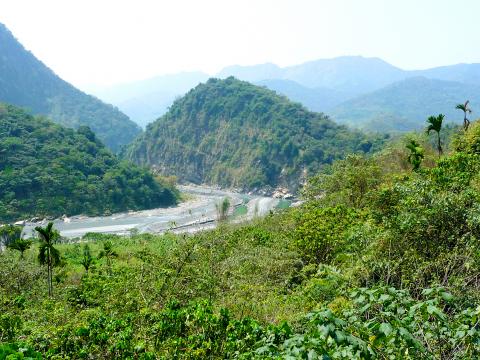
Photo: Steven Crook
From Shueili, it’s possible to go north to Sun Moon Lake, east to the end of Highway 16, or south along Highway 21 (also known as the New Central Cross Island Highway, 新中橫) to Tataka (塔塔加) and Alishan. There’s also County Road 61 (投61), which runs due south from the town center, crosses the Jhuoshuei River (濁水溪), and then soon peters out.
Much of the land between the town center and the river is devoted to mushroom farming. Shueili lies between 243 and 1,266m above sea level, sufficiently elevated for the cultivation of edible fungi without the need for artificial (and expensive) cooling of growing sheds.
Each mushroom operation is draped with black canvas to keep out sunlight. But after harvesting, some of the fungus crop is sun- and air-dried next to the road. Between the early 1960s and the late 1970s, Taiwan was the world’s no. 1 source of canned and bottled mushrooms. These days, most of the mushrooms grown in Taiwan are eaten in the country.
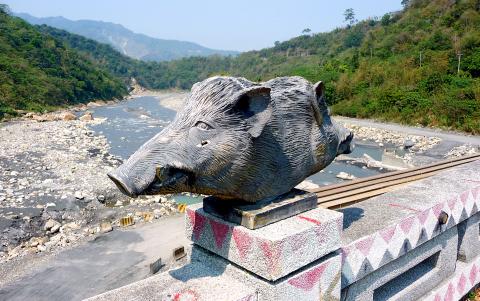
Photo: Steven Crook
As soon as I was on the southside of the river, I turned onto County Road 58 (投58) to look for a couple of unusual natural features. The spread-out village here is called Yongsing (永興) and consists of perhaps 30 households.
My first stop was Yongsing Giant Camphor Tree (永興神木), a 26m-tall sacred tree just past Yongsing Elementary School (永興國小). The tree is said to be more than 300 years old, and two of its descendants grow on the same site. Like sacred trees throughout Taiwan, they wear red sashes. A shrine to the land god completes a very pretty scene.
The road got steeper and rougher as I approached the second attraction. Yongsing Water and Fire (永興水火同源), 1.15km further along the same road at the 3.5km marker, is one of several places in Taiwan where natural gas seeps to the surface and burns, even when a puddle of water covers the ground. Or so it’s said. When I visited, neither flames nor water were visible. Not a failure, but certainly a disappointment.
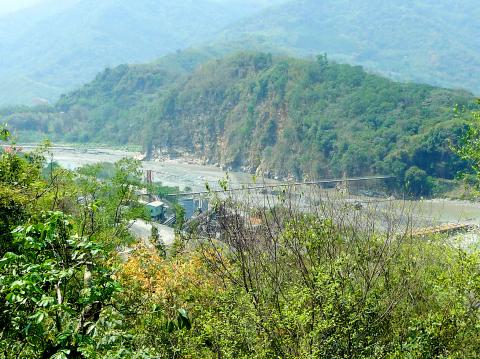
Photo: Steven Crook
Freewheeling back down the hill, past the old camphor trees, I took the designated bike trail that leads to Yongsing Suspension Bridge (永興吊橋). This hillside trail looks over the Jhuoshuei River as it makes an abrupt 90-degree turn, but the number of freshly-fallen rocks littering the path encouraged me to push on, rather than linger and enjoy the view.
What I saw when I reached the bridge confirmed what Google Maps had already told me. The other side was dominated by a gravel-extraction operation. The river here is more than 100m across, and crossing the bridge wasn’t a pleasant experience. I always feel nervous when faced with heights, a raging torrent and dangerous rocks. The poor state of the bridge made things worse. The cables holding it in place appeared to be intact, but the wooden planking didn’t inspire confidence. If I said some of the holes were big enough for skateboards to fall through, I’d hardly be exaggerating.
Due to the gravel piled on the other side, and the trucks which crushed everything beneath their wheels, a riverside that undoubtedly had once been crammed with foliage was bereft of greenery. To reach Highway 21, I had to work my way around pools of mud while dodging miniature dust-devils.
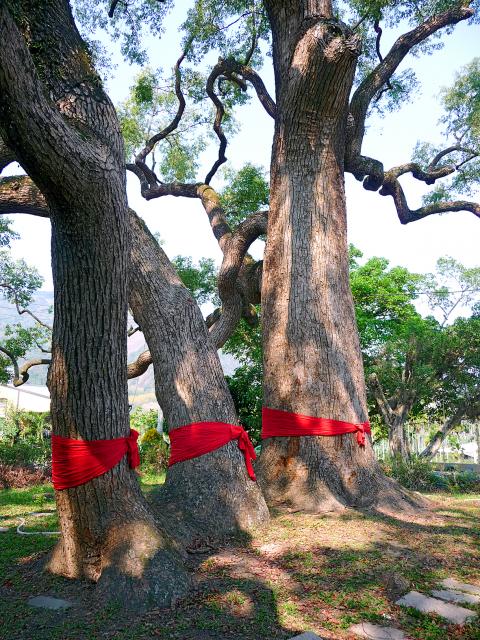
Photo: Steven Crook
My plan was to make my way south on Highway 21. Reaching Alishan was beyond me, I knew that much, but I wanted to see how I’d fare on this road as it climbed toward Sinyi Township (信義鄉).
I had the answer very soon. After 2km I turned around. I could handle the gradient, but not the gravel trucks that roared past me a few times every minute.
CONCRETE JUNGLE

Photo: Steven Crook
The demand for gravel is so strong because Taiwan has a love affair with concrete. A lot has been written about the environmental cost of this material. Local rivers have been so denuded of gravel that bridges have collapsed.
Just as some people suddenly become vegetarians after visiting a slaughterhouse, it wouldn’t surprise me if trying to ride a bicycle between the gravel trucks that roar along Highway 21 has turned some people against the use of concrete as a construction material. I experienced no such conversion, because years ago, after reading about the cement industry, I decided I’d never initiate the building of a new concrete structure. Taiwan boasts some splendid examples of sustainable architecture, but the pouring of concrete has yet to abate.
Determined to get something out of the day, I cycled to the junction of Highway 21 and Highway 16, and turned on to the latter. It was blissfully free of gravel trucks, so I set myself a modest objective. Instead of continuing on to Dili (地利) or even the end of the road, at a fork I turned southeast to Renlun (人倫), an indigenous village also known by its Bunun name, Langdun.
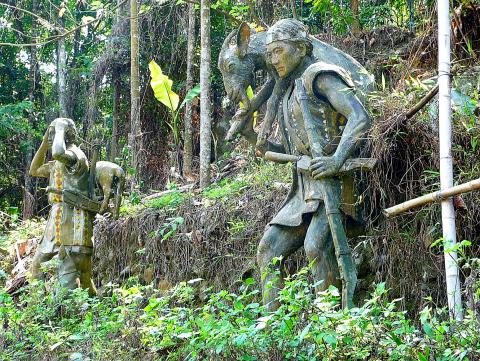
Photo: Steven Crook
The distance was short, less than 3km, but I got a good workout. The road first plunges down to the river, where there are statues of previous village chiefs and a bridge decorated with concrete wild-boar heads. It’s then a tough grind up to a densely-arranged community which supports two churches and an elementary school.
The people were friendly, and one of them told me my achievement was nothing short of amazing. I suspect the subtext may have been “...for a puny city-dweller,” but at last I was feeling satisfied with the day’s exploring. Now if only those gravel trucks would disappear.
Steven Crook has been writing about travel, culture, and business in Taiwan since 1996. Having recently co-authored A Culinary History of Taipei: Beyond Pork and Ponlai, he is now updating Taiwan: The Bradt Travel Guide.

Photo: Steven Crook

The unexpected collapse of the recall campaigns is being viewed through many lenses, most of them skewed and self-absorbed. The international media unsurprisingly focuses on what they perceive as the message that Taiwanese voters were sending in the failure of the mass recall, especially to China, the US and to friendly Western nations. This made some sense prior to early last month. One of the main arguments used by recall campaigners for recalling Chinese Nationalist Party (KMT) lawmakers was that they were too pro-China, and by extension not to be trusted with defending the nation. Also by extension, that argument could be

Aug. 4 to Aug. 10 When Coca-Cola finally pushed its way into Taiwan’s market in 1968, it allegedly vowed to wipe out its major domestic rival Hey Song within five years. But Hey Song, which began as a manual operation in a family cow shed in 1925, had proven its resilience, surviving numerous setbacks — including the loss of autonomy and nearly all its assets due to the Japanese colonial government’s wartime economic policy. By the 1960s, Hey Song had risen to the top of Taiwan’s beverage industry. This success was driven not only by president Chang Wen-chi’s

Last week, on the heels of the recall election that turned out so badly for Taiwan, came the news that US President Donald Trump had blocked the transit of President William Lai (賴清德) through the US on his way to Latin America. A few days later the international media reported that in June a scheduled visit by Minister of National Defense Wellington Koo (顧立雄) for high level meetings was canceled by the US after China’s President Xi Jinping (習近平) asked Trump to curb US engagement with Taiwan during a June phone call. The cancellation of Lai’s transit was a gaudy

The centuries-old fiery Chinese spirit baijiu (白酒), long associated with business dinners, is being reshaped to appeal to younger generations as its makers adapt to changing times. Mostly distilled from sorghum, the clear but pungent liquor contains as much as 60 percent alcohol. It’s the usual choice for toasts of gan bei (乾杯), the Chinese expression for bottoms up, and raucous drinking games. “If you like to drink spirits and you’ve never had baijiu, it’s kind of like eating noodles but you’ve never had spaghetti,” said Jim Boyce, a Canadian writer and wine expert who founded World Baijiu Day a decade